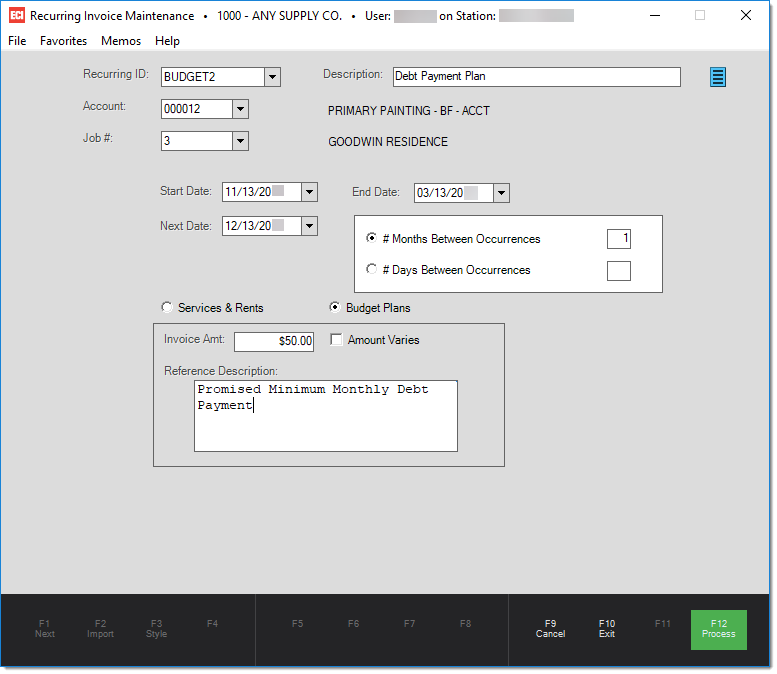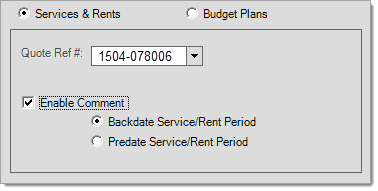Recurring Invoices
The Recurring Invoices database form (located in Receivables on the Database menu) can be used to designate either a service billing or budget plan for a customer. This should not be confused with the "recurring bills" option for Payables.
In both cases, these options are associated with a specific customer account. Bills may be printed (or delivered via Email/Fax) from the Invoice Recurring utility located in both the Point of Sale and Receivables areas. Bills are not retained as documents and are not generated (delivered) automatically. Here is a description of each type of recurring invoice plan:

Recurring Invoice Maintenance (Receivables)
There are two (2) flavors of recurring invoices: "service & rents" and "budget plans."
Service Billing can be used to produce a recurring charge to a customer. This might be used for long-term rentals (storage, for example) or any other service (lawn care, snow removal, etc.) where a customer is billed on a regular schedule for the same amount.
Service billing is linked with a "template" transaction (a quote specifically) that determines the amount being charged. If quote "locking" is enabled, it can be used to duplicate a quote for many different accounts if recurring "services & rents" are similar. The "quote locking" feature must be enabled by support. The item(s) on the quote are invoiced when the service bill is generated, and should reflect the service being charged to the customer. If the service is taxable or not, the item's taxable setting should reflect whichever is appropriate.

Service Settings for Recurring Invoice
Enable Comment
The "Enable Comment" check box determines whether the frequency and date of the recurring invoice should be used to generate a comment on the document indicating the service period being billed. This is optional. The service period dates for the comment, if used, can either end with (backdate) or begin with (predate) the service date. The back date period (date range) ends with the service date, and the predate period begins with the service date. The comment is displayed below the address boxes on the invoice and appears similar to the following:
"Billing for period from 2/11/2016 - 3/10/2016"
Choose the "Services & Rents" radio button to select this type of recurring invoice.
Budget billing is similar but doesn't generate any debit to the customer's account, so it's just a billing function and payments are applied to an existing balance or new invoicing. The difference between a budget billing and service billing is that the budget amount does not necessarily equal the total being charged or due.
For example, if your company sells heating oil, you could use budget billing and charge customers an estimated monthly amount equal to 1/12 their previous year's usage. Each time oil is delivered, a regular invoice would be generated as a charge to the account recording the amount of oil delivered at that time. The budget amount stays the same all year but the amount billed varies. Each month, the customer pays the billed amount and that amount is applied to the balance (or open items) on the account. This may or may not pay the entire balance and in some cases, may leave a credit balance on the customer's account. At the end of the year, the customer may be required to pay any difference (or the next year's budget may just be higher to include the difference plus any rise in costs).
Another possible use is for layaway plans or an extended payment plan on a major purchase (an installed sale, farm equipment, etc.).
Budget billing can also be used as a way to manage a special payment plan for a customer who owes your company money (bad debt) but is only able to pay less than the balance due. In this case, the customer would receive a bill for what the agreed payment is instead of what's due in total. A budget plan customer would not be able to have an active charge account that is also used for budget billing... a separate account would be required for budget billing.
Choose the "Budget Plans" radio button to select this type of recurring invoice.
Recurring ID
This is a code that will be used to identify the recurring invoice for selection. Any unique identifier up to 16-characters in length may be used. If you plan on using recurring invoices for various reasons, you might want to prefix similar codes with the same character(s) so that similar billing plans appear together in the listing. Once added, "services & rents" and "budget plans" can be identified based upon the "Quote ID" in the drop down (only "services & rents" are associated with a quote).
Description
The description entered is included on the bill that is printed or transmitted to the customer.
Account / Job
These fields are used for specifying the customer and job that is associated with the recurring invoice plan. For certain types of billing, a separate account may be necessary if the customer already has an active account.
Start Date
This is the beginning date of the plan. A payment plan can be set up in advance for a particular start date if needed. This date does not determine when the actual bill would be produced.
End Date
This is the ending date of the plan. After this date, the "next date" field is no longer advanced and no new bills will be generated.
Next Date
This date is automatically incremented each time a bill is produced from the Invoice Recurring utility. The "# Months Between Occurrences" determines how many months the date is incremented by each time bills are processed. This date also determines what date that the bill will be eligible for delivery (printing, Email, or faxing). If needed, the "next" date can be manually adjusted (if you need to reprint/resent a bill, for example). Bills are not retained as documents and cannot be reprinted otherwise.
Frequency
There are two (2) frequency options: number of months or number of days. If the recurring invoice should be generated every month on the same day of the month (such as the 25th, for example), you would use the "# Months" option. If the recurring invoice is weekly (7-days), bi-weekly (14-days), 28-day cycle, or yearly, for some examples, use the "# days" option.
# Months Between Occurrences
This determines the difference in months used when setting the "next date" whenever a bill is processed from the Invoice Recurring utility. In this case, the day of the month remains consistent. For example, set this field to 1 (one) if you want to produce a bill on the same day in the following month. If the next date is set to February 25, 2025 and the "# Month Between Occurrences" is 2, when bills are produced for the 2/25/2025 billing, the next date would then be incremented to April 25, 2025 (March is skipped because the month setting is 2, not 1).
# Days Between Occurrences
This determines the difference in days used when setting the "next date" whenever a bill is processed from the Invoice Recurring utility. In this case, the day of billing won't be consistently the same day of the month; however, it could be used to bill the same day of the week if multiples of seven (7) are used. For example, set this field to seven (7) if you want to produce a bill on the same day in the following week. If the next date is set to Friday, August 7, 2025 and the "# Days Between Occurrences" is 7, when bills are produced for that week's billing, the next date would then be incremented to Friday, August 14, 2025.
Services & Rents
When "services & rents" is selected, the panel below is used for selecting a "quote" template that defines the billing amount.
Budget Plan
When "budget plan" is selected, the panel below is used for specifying the billing amount, whether or not the amount may be changed, and a reference to be printed on the bill.